A Modular Plug-And-Play Sensor System for Urban Air Pollution Monitoring: Design, Implementation and Evaluation
Abstract
:1. Introduction
- A Modular Sensor System (MSS) architecture with multiple WSN compatibility, configurable and expandable sensing capabilities, and plug-and-play ability;
- A Universal Sensor Interface (USI) enabling modular hardware/software design, configurable and expandable sensing capabilities, and plug-and-play ability;
- Implementing and evaluating a MSS sensor node prototype having six plug-and-play sensor modules (The sensor node supports at most 16 sensor modules logically and electronically. Limited by the size and weight, only six physical USI sockets were implemented. The number of the physical USI sockets can be easily upgraded to 16.) and supporting multiple WSNs, which has good applicability and can fit in different deployment scenarios.
2. Related Works
3. System Architecture and Implementation
3.1. Design Goals
- G.1
- G.2
- Energy Efficiency: The portability of a sensor node is achieved at the expense of limited size, weight, and power. A sensor node with high energy efficiency can increase the flexibility of maintenance by reducing the charging frequency.
- G.3
- Multiple WSN Compatibility: A sensor node with multiple WSN compatibility can be deployed in stationary, wearable, or vehicular scenarios by replacing the wireless module only, while having satisfying trade-off among network connectivity, energy consumption, and cost efficiency.
- G.4
- G.5
- Configurable and Adaptable Sensing Capability: By employing modular software/hardware design, the number and types of sensors on a sensor node are user-configurable and self-adaptable (i.e., plug-and-play) for different kinds of monitoring scenarios that increase the system flexibility and usability, while the sensors’ sensing intervals are self-configured for power managing and detection maximizing purposes. System evolution is cost-efficiently achieved by developing advanced sensor modules for existing sensor nodes.
3.2. System Architecture Design
3.3. Detailed Implementation
3.3.1. Main Body Subsystem
3.3.2. Sensor-Module Subsystem
4. Evaluation and Calibration
4.1. Functional Evaluation
4.2. Collocation Calibration
| Algorithm 1: Pairwise calibration algorithm proposed in [46] |
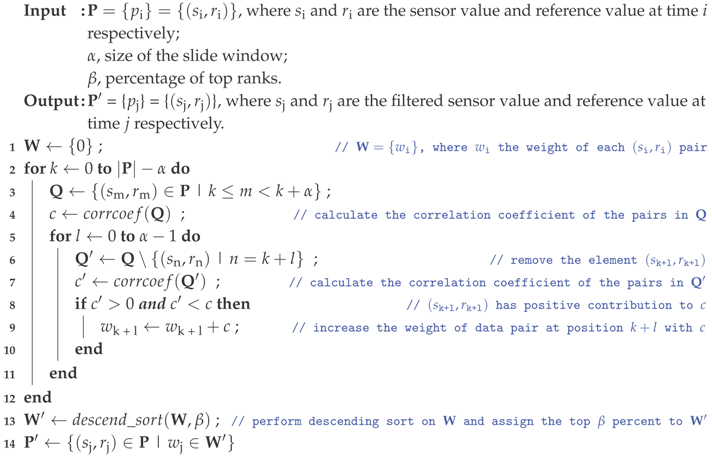 |
5. Conclusions
Acknowledgments
Author Contributions
Conflicts of Interest
Appendix A
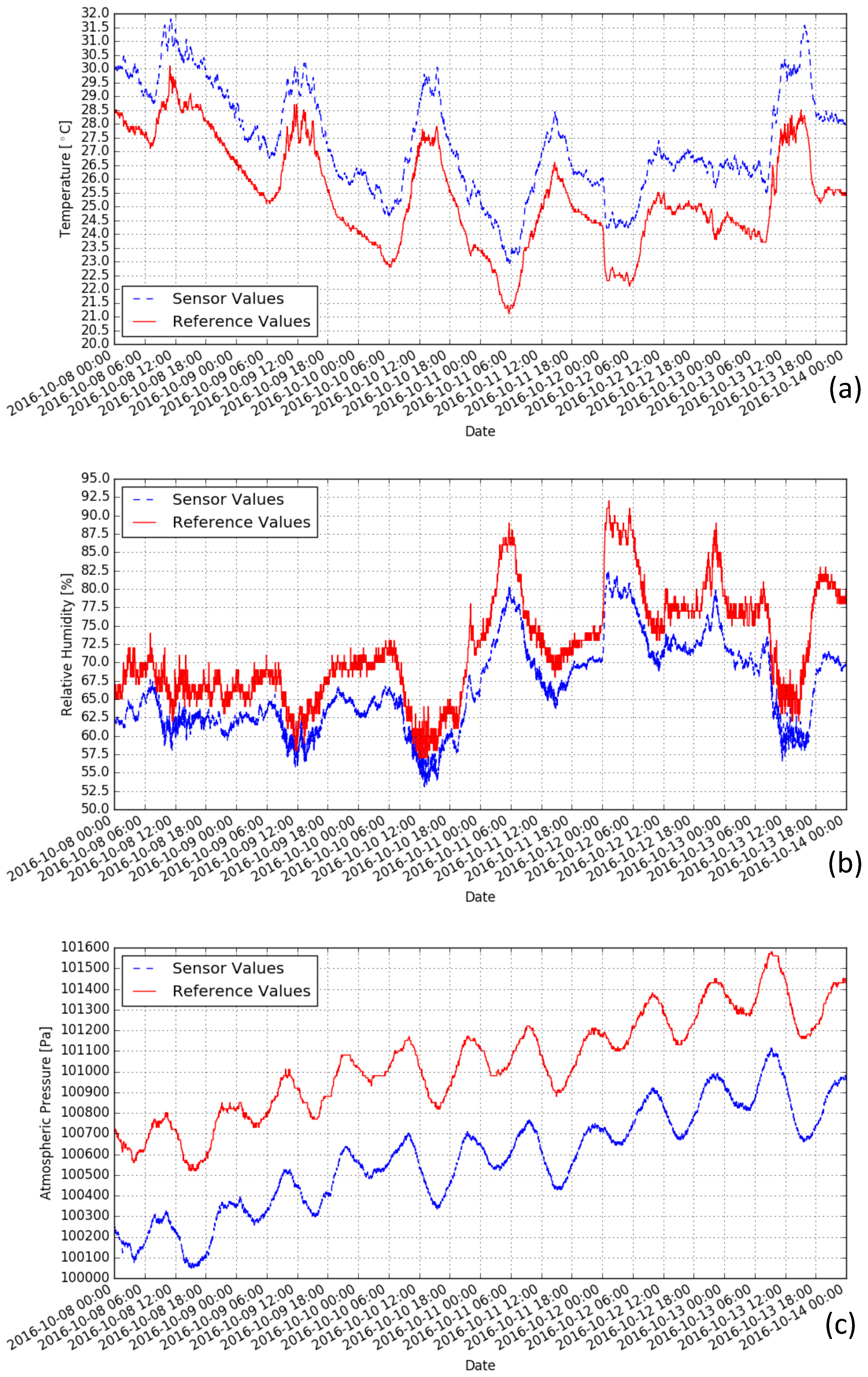
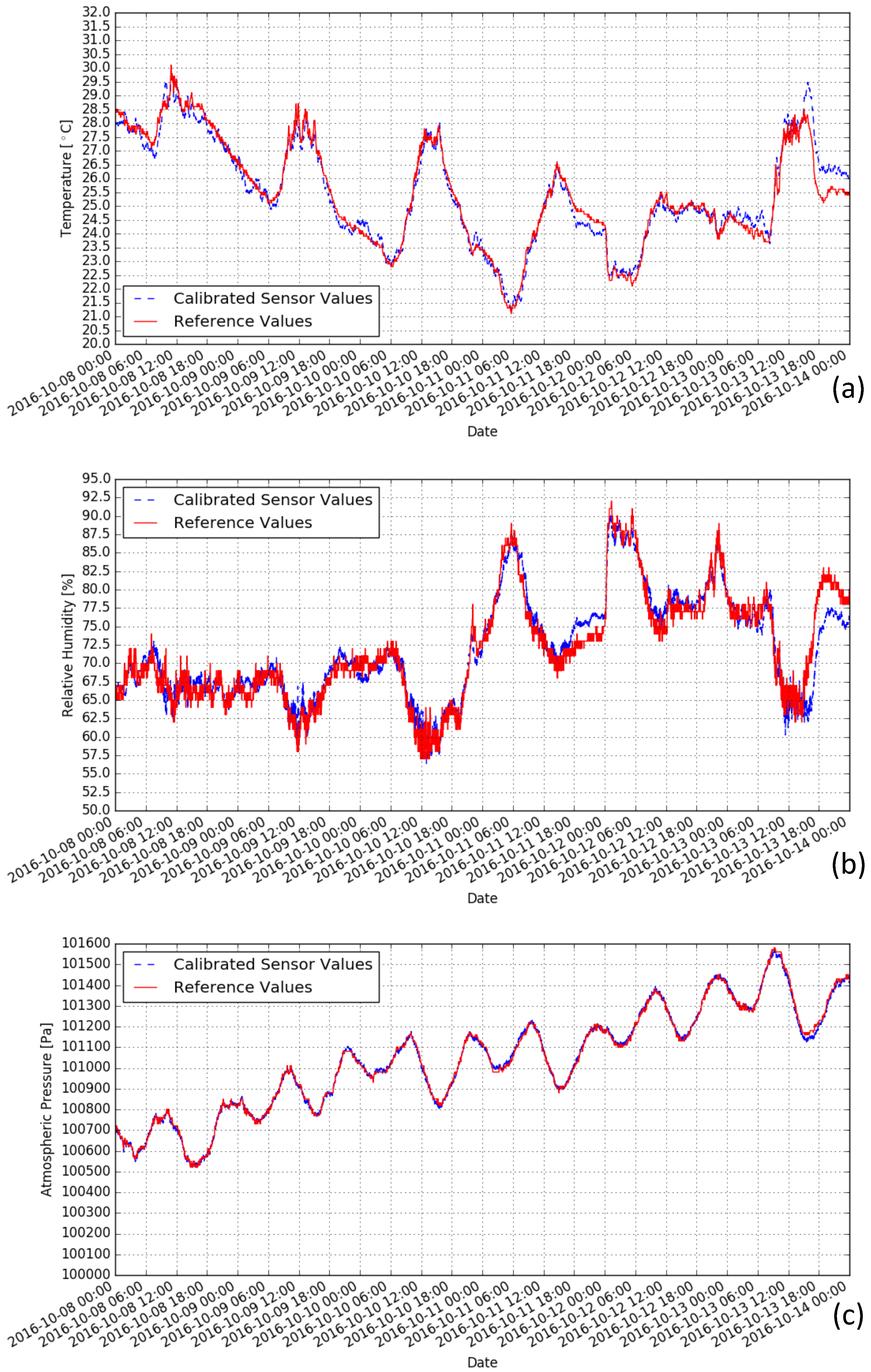
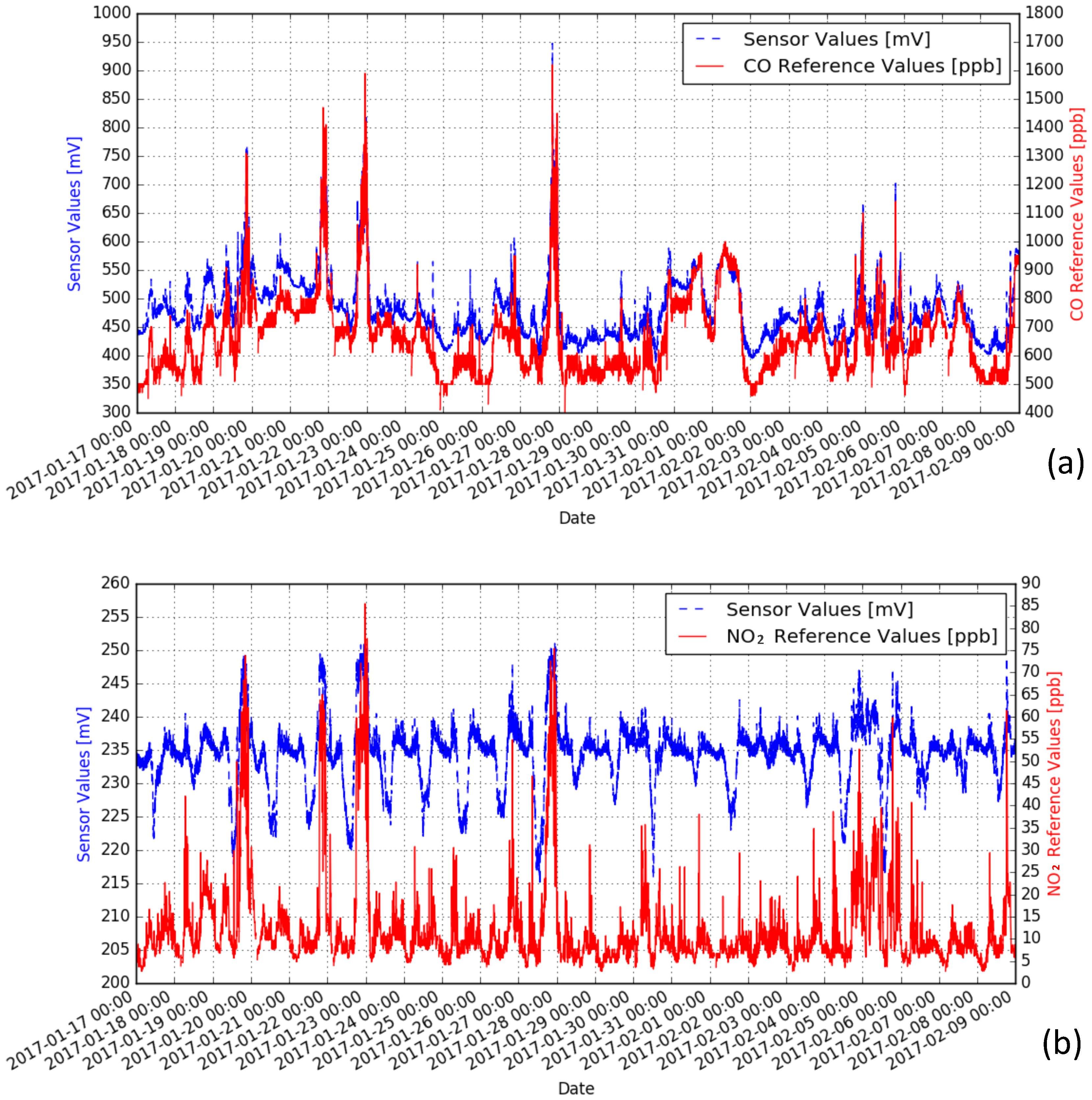
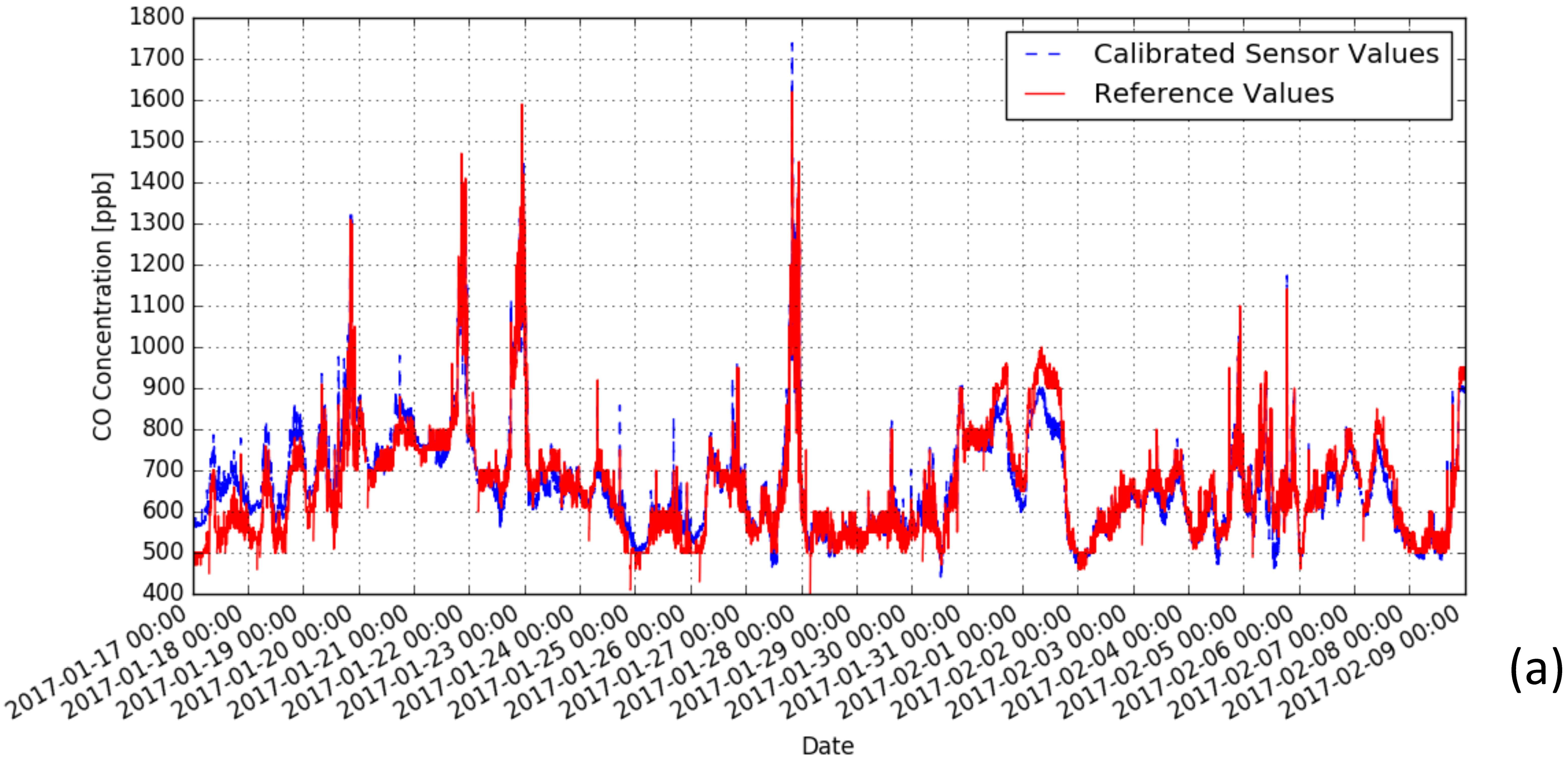
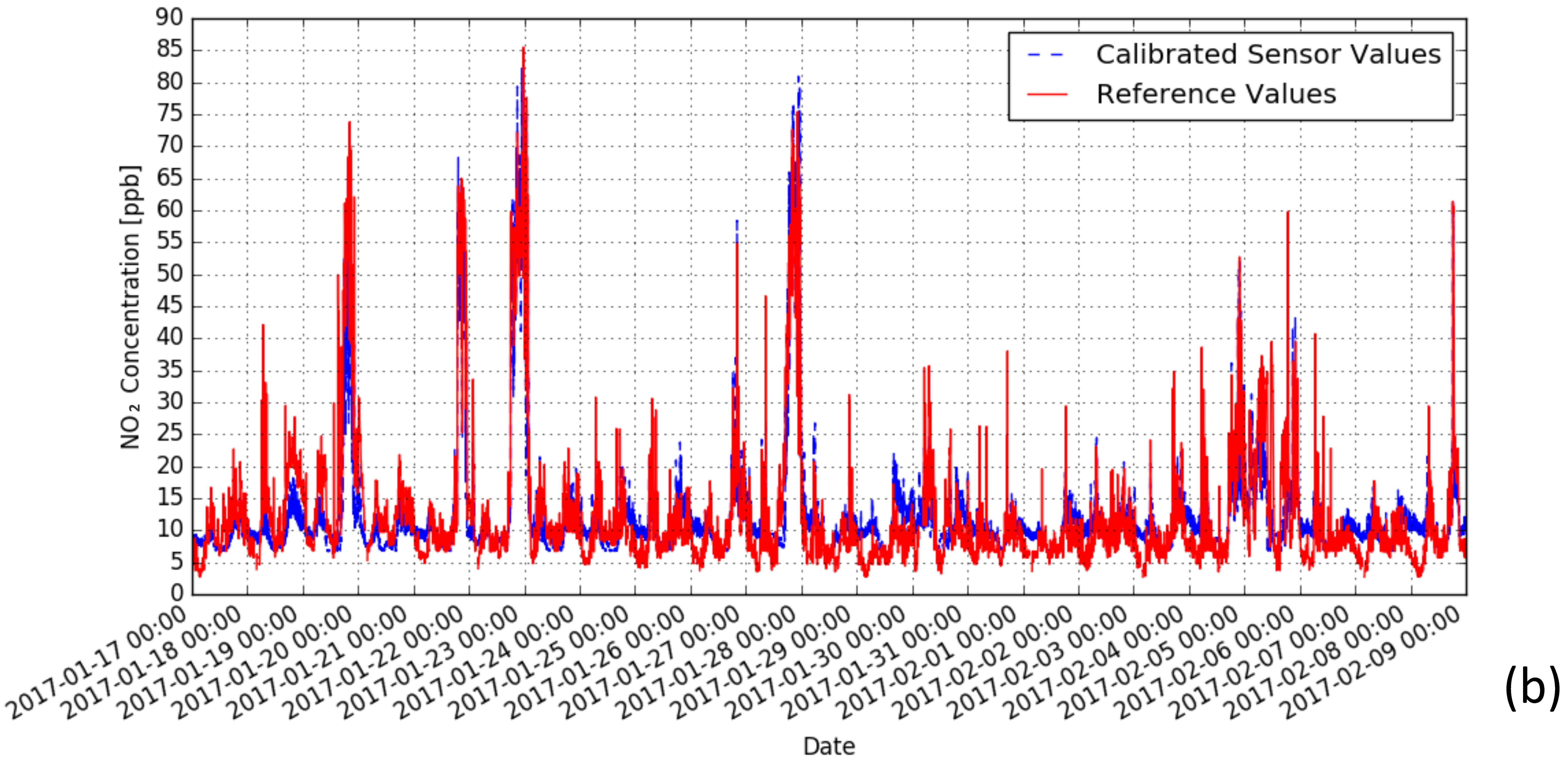
References
- World Health Organization. 7 Million Premature Deaths Annually Linked to Air Pollution. 2014. Available online: http://www.who.int/mediacentre/news/releases/2014/air-pollution/en/ (accessed on 5 December 2017).
- Romley, J.A.; Hackbarth, A.; Goldman, D.P. The Impact of Air Quality on Hospital Spending; RAND Corporation: Santa Monica, CA, USA, 2010. [Google Scholar]
- Yi, W.Y.; Lo, K.M.; Mak, T.; Leung, K.S.; Leung, Y.; Meng, M.L. A survey of wireless sensor network based air pollution monitoring systems. Sensors 2015, 15, 31392–31427. [Google Scholar] [CrossRef] [PubMed]
- Environmental Protection Department of Hong Kong. Air Quality Health Index. Available online: http://www.aqhi.gov.hk/en.html (accessed on 5 December 2017).
- Hoek, G.; Krishnan, R.M.; Beelen, R.; Peters, A.; Ostro, B.; Brunekreef, B.; Kaufman, J.D. Long-term air pollution exposure and cardio-respiratory mortality: A review. Environ. Health 2013, 12, 43. [Google Scholar] [CrossRef] [PubMed]
- Yu, O.; Sheppard, L.; Lumley, T.; Koenig, J.Q.; Shapiro, G.G. Effects of ambient air pollution on symptoms of asthma in seattle-area children enrolled in the CAMP study. Environ. Health Perspect. 2000, 108, 1209–1214. [Google Scholar] [CrossRef] [PubMed]
- Pope, C.A., III; Verrier, R.L.; Lovett, E.G.; Larson, A.C.; Raizenne, M.E.; Kanner, R.E.; Schwartz, J.; Villegas, G.; Gold, D.R.; Dockery, D.W. Heart rate variability associated with particulate air pollution. Am. Heart J. 1999, 138, 890–899. [Google Scholar] [CrossRef]
- Peters, A.; Dockery, D.W.; Muller, J.E.; Mittleman, M.A. Increased particulate air pollution and the triggering of myocardial infarction. Circulation 2001, 103, 2810–2815. [Google Scholar] [CrossRef] [PubMed]
- Kilaru, V.; Williams, R. Next Generation Air Monitoring (NGAM)—Technology Evaluation and application Research. 2016. Available online: https://www.gob.mx/cms/uploads/attachment/file/171794/20160629_calidadAire_CM_EPA_V_Kilaru.pdf (accessed on 5 December 2017).
- Postolache, O.A.; Pereira, J.M.D.; Girao, P.M.B.S. Smart sensors network for air quality monitoring applications. IEEE Trans. Instrum. Meas. 2009, 58, 3253–3262. [Google Scholar] [CrossRef]
- Jelicic, V.; Magno, M.; Brunelli, D.; Paci, G.; Benini, L. Context-adaptive multimodal wireless sensor network for energy-efficient gas monitoring. IEEE Sens. J. 2013, 13, 328–338. [Google Scholar] [CrossRef]
- Lo Re, G.; Peri, D.; Vassallo, S. Urban air quality monitoring using vehicular sensor networks. In Advances onto the Internet of Things; Gaglio, S., Lo Re, G., Eds.; Springer International Publishing: Berlin, Germany, 2014; Volume 260, pp. 311–323. [Google Scholar]
- Mansour, S.; Nasser, N.; Karim, L.; Ali, A. Wireless sensor network-based air quality monitoring system. In Proceedings of the 2014 International Conference on Computing, Networking and Communications (ICNC), Honolulu, HI, USA, 3–6 February 2014; pp. 545–550. [Google Scholar]
- Capezzuto, L.; Abbamonte, L.; De Vito, S.; Massera, E.; Formisano, F.; Fattoruso, G.; Di Francia, G.; Buonanno, A. A maker friendly mobile and social sensing approach to urban air quality monitoring. In Proceedings of the 2014 IEEE on SENSORS, Valencia, Spain, 2–5 November 2014; pp. 12–16. [Google Scholar]
- Zheng, K.; Zhao, S.; Yang, Z.; Xiong, X.; Xiang, W. Design and implementation of LPWA-based air quality monitoring system. IEEE Access 2016, 4, 3238–3245. [Google Scholar] [CrossRef]
- Murty, R.N.; Mainland, G.; Rose, I.; Chowdhury, A.R.; Gosain, A.; Bers, J.; Welsh, M. Citysense: An urban-scale wireless sensor network and testbed. In Proceedings of the 2008 IEEE Conference on Technologies for Homeland Security, Waltham, MA, USA, 12–13 May 2008; pp. 583–588. [Google Scholar]
- Dutta, P.; Aoki, P.M.; Kumar, N.; Mainwaring, A.; Myers, C.; Willett, W.; Woodruff, A. Common sense: Participatory urban sensing using a network of handheld air quality monitors. In Proceedings of the 7th ACM Conference on Embedded Networked Sensor Systems, Berkeley, CA, USA, 4–6 November 2009; ACM: New York, NY, USA, 2009; pp. 349–350. [Google Scholar]
- Jiang, Y.; Li, K.; Tian, L.; Piedrahita, R.; Yun, X.; Mansata, O.; Lv, Q.; Dick, R.P.; Hannigan, M.; Shang, L. MAQS: A personalized mobile sensing system for indoor air quality monitoring. In Proceedings of the 13th International Conference on Ubiquitous Computing, Beijing, China, 17–21 September 2011; ACM: New York, NY, USA, 2011; pp. 271–280. [Google Scholar]
- Hasenfratz, D.; Saukh, O.; Sturzenegger, S.; Thiele, L. Participatory air pollution monitoring using smartphones. Mobile Sensing 2012, 1, 1–5. [Google Scholar]
- Kadri, A.; Yaacoub, E.; Mushtaha, M.; Abu-Dayya, A. Wireless sensor network for real-time air pollution monitoring. In Proceedings of the 2013 1st International Conference on Communications, Signal Processing, and their applications (ICCSPA), Sharjah, United Arab Emirates, 12–14 February 2013; pp. 1–5. [Google Scholar]
- Sun, L.; Wong, K.C.; Wei, P.; Ye, S.; Huang, H.; Yang, F.; Westerdahl, D.; Louie, P.K.; Luk, C.W.; Ning, Z. Development and application of a next generation air sensor network for the Hong Kong marathon 2015 air quality monitoring. Sensors 2016, 16, 211. [Google Scholar] [CrossRef] [PubMed]
- Yi, W.Y.; Leung, K.S.; Leung, Y.; Meng, M.L.; Mak, T. Modular sensor system (MSS) for urban air pollution monitoring. In Proceedings of the 2016 IEEE on SENSORS, Orlando, FL, USA, 30 Octorber–3 November 2016; pp. 1–3. [Google Scholar]
- Honicky, R.; Brewer, E.A.; Paulos, E.; White, R. N-smarts: Networked suite of mobile atmospheric real-time sensors. In Proceedings of the Second ACM SIGCOMM Workshop on Networked Systems for Developing Regions, Seattle, WA, USA, 18 August 2008; ACM: New York, NY, USA, 2008; pp. 25–30. [Google Scholar]
- Lane, N.D.; Miluzzo, E.; Lu, H.; Peebles, D.; Choudhury, T.; Campbell, A.T. A survey of mobile phone sensing. IEEE Commun. Mag. 2010, 48, 140–150. [Google Scholar] [CrossRef]
- Helbig, C.; Bauer, H.S.; Rink, K.; Wulfmeyer, V.; Frank, M.; Kolditz, O. Concept and workflow for 3D visualization of atmospheric data in a virtual reality environment for analytical approaches. Environ. Earth Sci. 2014, 72, 3767–3780. [Google Scholar] [CrossRef]
- Aberer, K.; Sathe, S.; Chakraborty, D.; Martinoli, A.; Barrenetxea, G.; Faltings, B.; Thiele, L. OpenSense: Open community driven sensing of environment. In Proceedings of the GIS-IWGS, San Jose, CA, USA, 2 November 2010; pp. 39–42. [Google Scholar]
- Balz, M. Sense the Air You Breathe! Ph.D. Thesis, ETH-Zürich, Zürich, Switzerland, 2013. [Google Scholar]
- Wong, K.J.; Chua, C.C.; Li, Q. Environmental monitoring using wireless vehicular sensor networks. In Proceedings of the 5th International Conference on Wireless Communications, Networking and Mobile Computing, Beijing, China, 24–26 September 2009; pp. 1–4. [Google Scholar]
- Aleixandre, M.; Gerboles, M. Review of small commercial sensors for indicative monitoring of ambient gas. Chem. Eng. Trans. 2012, 30, 169–174. [Google Scholar]
- Gerboles, M.; Buzica, D. Evaluation of Micro-sensors to Monitor Ozone in Ambient Air; EUR-Scientific and Technical Research, European Commission; Office for Official Publications of the European Communities: Rue Mercier, Luxembourg, 2009. [Google Scholar]
- ARMmbed-IoT Device Platform. Available online: https://www.mbed.com/en/ (accessed on 5 December 2017).
- Xbee: Connect Devices To The Cloud-Digi International. Available online: http://www.digi.com/lp/xbee (accessed on 5 December 2017).
- Chou, J. Sensor selection guide. In Hazardous Gas Monitors—A Practical Guide to Selection, Operation and applications; McGraw-Hill and SciTech Publishing: New York, NY, USA, 1999; Chapter 8; pp. 103–109. [Google Scholar]
- CO-B4 Carbon Monoxide Sensor 4-Electrode. 2015. Available online: http://www.alphasense.com/WEB1213/wp-content/uploads/2015/04/COB41.pdf (accessed on 5 December 2017).
- SO2-B4 Sulfur Dioxide Sensor 4-Electrode. 2017. Available online: http://www.alphasense.com/WEB1213/wp-content/uploads/2017/05/SO2-B4.pdf (accessed on 5 December 2017).
- OX-B431 Oxidising Gas Sensor Ozone + Nitrogen Dioxide 4-Electrode. 2017. Available online: http://www.alphasense.com/WEB1213/wp-content/uploads/2017/07/OX-B431.pdf (accessed on 5 December 2017).
- NO2-B43F Nitrogen Dioxide Sensor 4-Electrode. 2017. Available online: http://www.alphasense.com/WEB1213/wp-content/uploads/2017/07/NO2B43F.pdf (accessed on 5 December 2017).
- Individual Sensor Board (ISB) Alphasense B4 4-Electrode Gas Sensors. 2016. Available online: http://www.alphasense.com/WEB1213/wp-content/uploads/2016/10/ISB.pdf (accessed on 5 December 2017).
- Mobile Sensing Technology. UPOD—An Open Source Platform for Mobile Air Quality Monitoring. Available online: http://mobilesensingtechnology.com (accessed on 5 December 2017).
- Variable Inc. Make the NODE+ Platform Your Foundation. Available online: http://www.variableinc.com/node1 (accessed on 5 December 2017).
- Li, J.J.; Faltings, B.; Saukh, O.; Hasenfratz, D.; Beutel, J. Sensing the air we breathe—the opensense Zurich dataset. In Proceedings of the National Conference on Artificial Intelligence, Toronto, ON, Canada, 22–26 July 2012; Volume 1, pp. 323–325. [Google Scholar]
- Speck—The Indoor Air Quality Monitor Empowering You to Breathe Easier. Available online: https://www.specksensor.com (accessed on 5 December 2017).
- AirBeam—Your Air Quality Sensor. Available online: http://aircasting.org (accessed on 5 December 2017).
- Wicked Device LLC. What is the Egg? Available online: https://airqualityegg.wickeddevice.com (accessed on 5 December 2017).
- KD Engineering. AirBoxx Monitor. Available online: http://www.afcintl.com/pdfs/KD%20pdfs/airboxx.pdf (accessed on 5 December 2017).
- Bychkovskiy, V.; Megerian, S.; Estrin, D.; Potkonjak, M. A collaborative approach to in-place sensor calibration. In Information Processing in Sensor Networks; Springer: Berlin/Heidelberg, Germany, 2003; pp. 301–316. [Google Scholar]
- Environmental Protection Department of Hong Kong. Hong Kong’s Air Quality Objectives. Available online: http://www.epd.gov.hk/epd/english/environmentinhk/air/air_quality_objectives/air_quality_objectives.html (accessed on 5 December 2017).

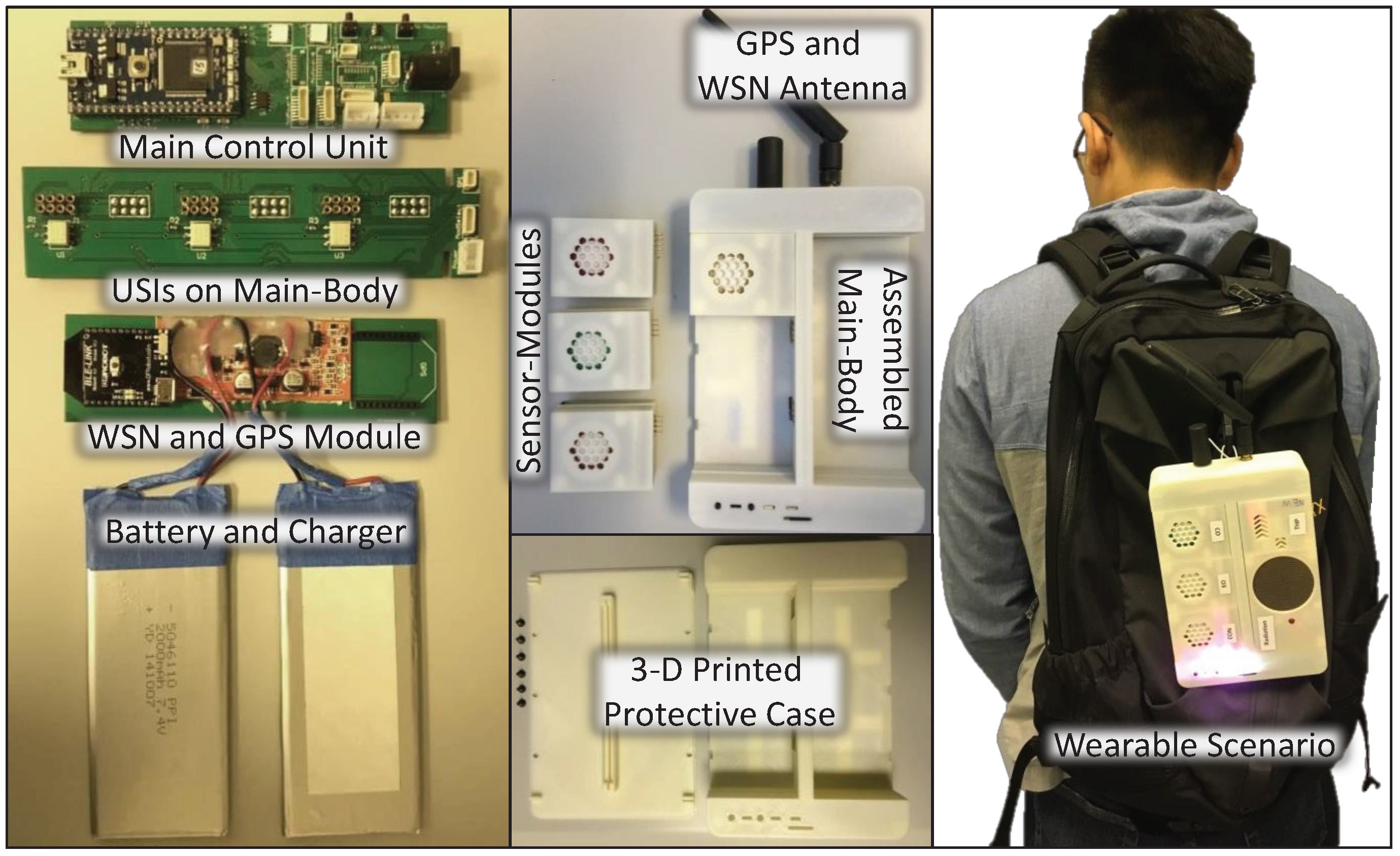

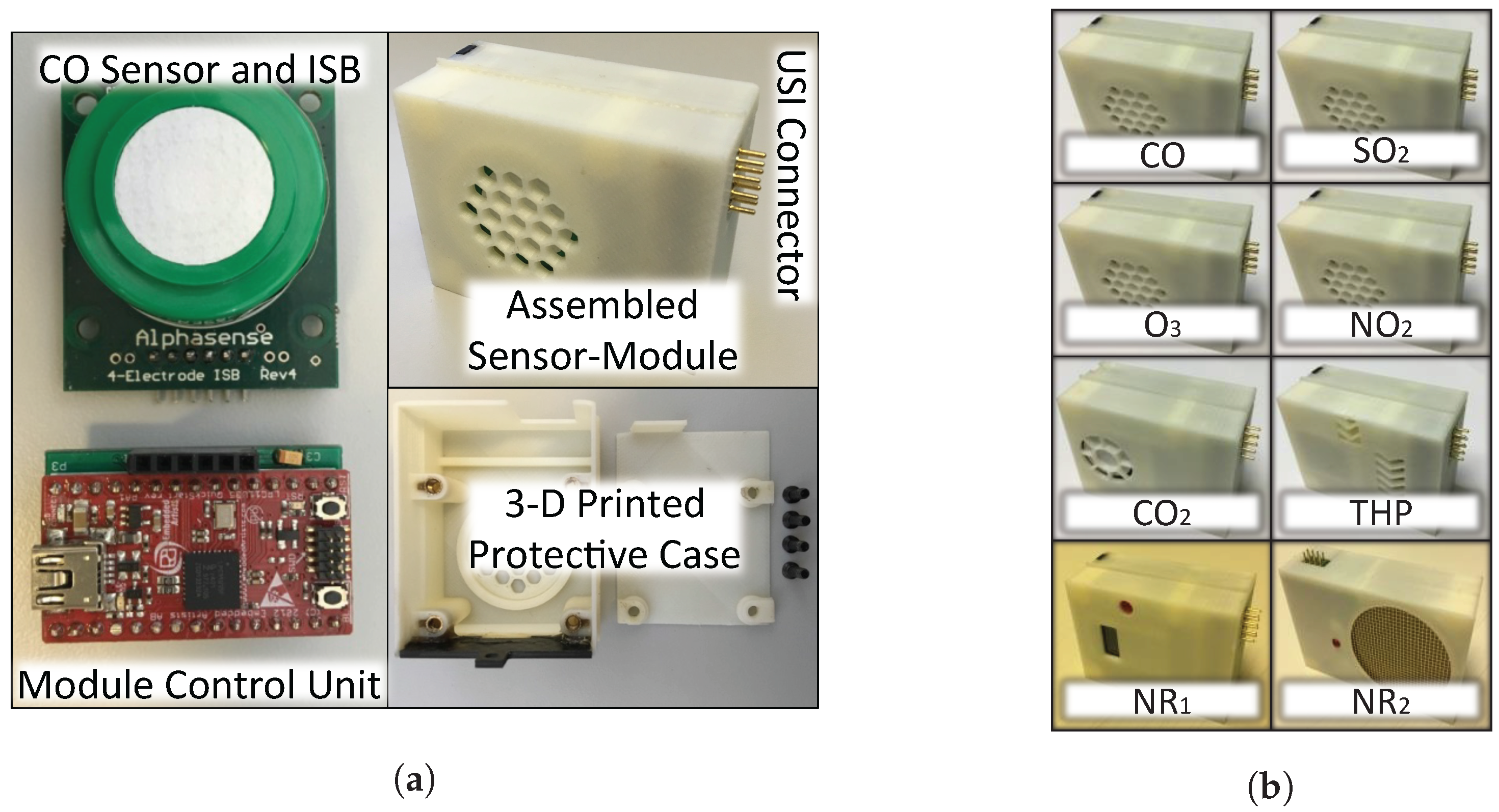
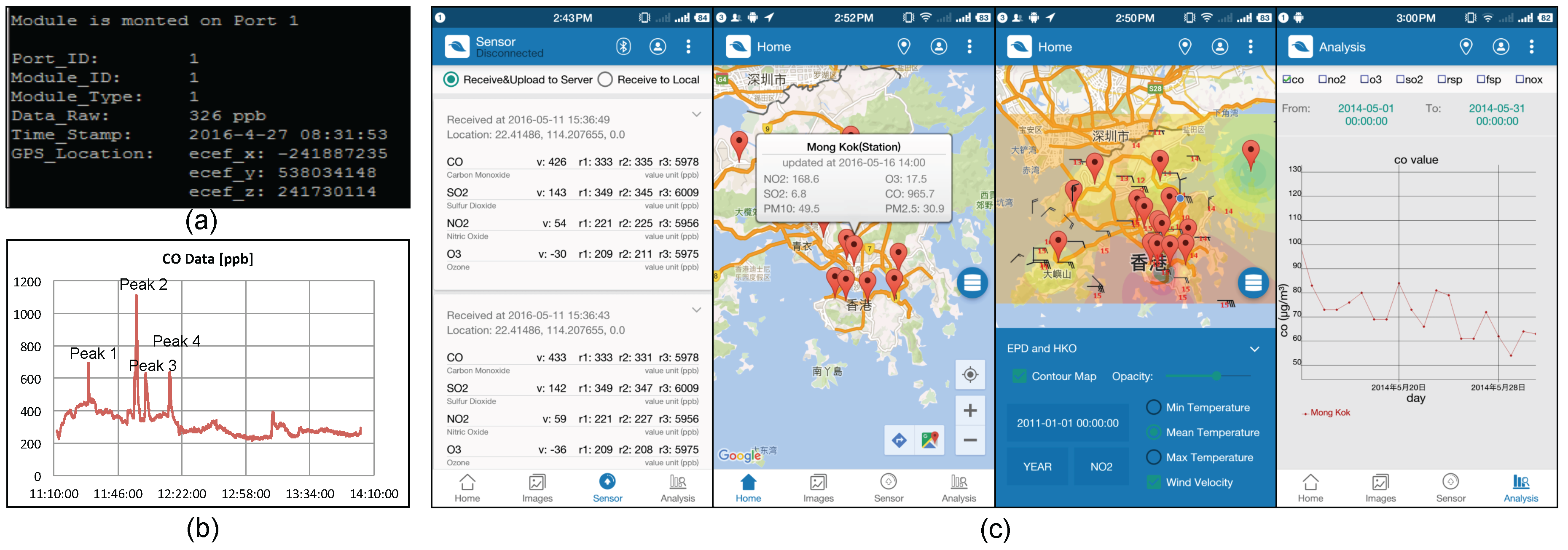
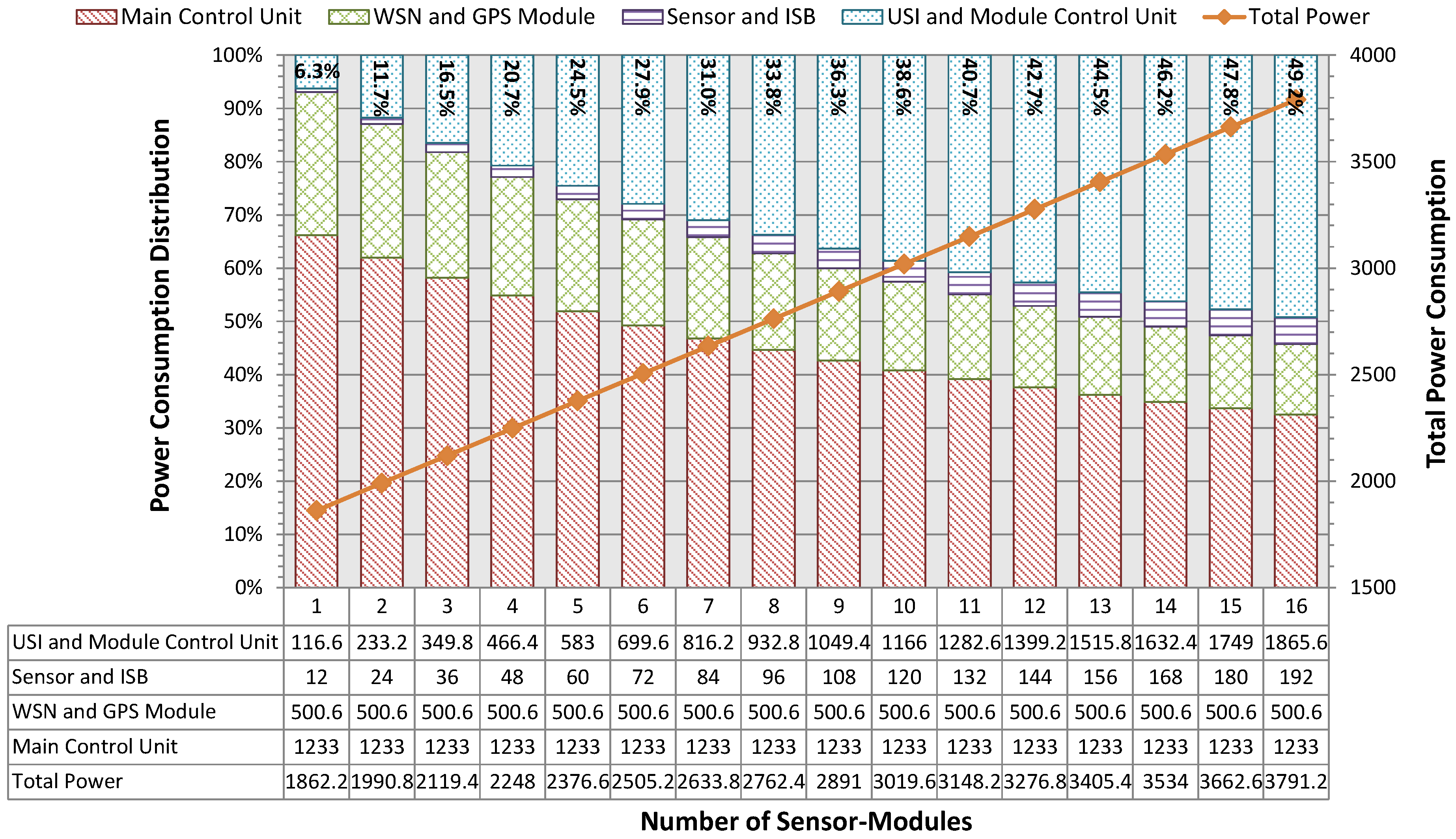


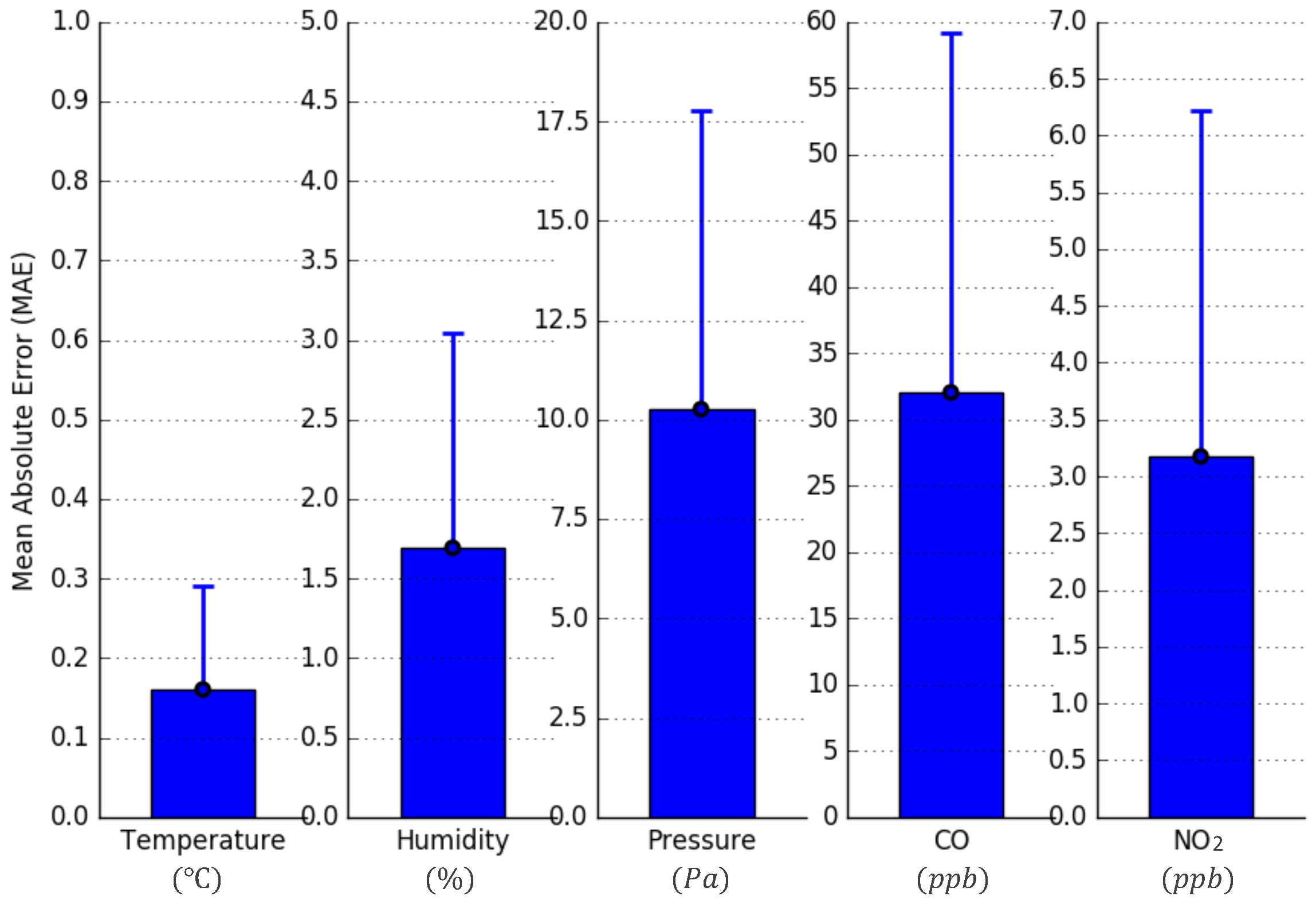
| Parameters | CO | NO2 | SO2 | O3 | NO | H2S |
|---|---|---|---|---|---|---|
| Precision ^ [ppb] | 4 | 15 | 5 | 15 | 15 | 1 |
| Sensor Sensitivity ^ [nA/ppb] | 0.525 | −0.425 | 0.35 | −0.4 | 0.65 | 1.75 |
| ISB Gain ^ [mV/nA] | 0.8 | −0.726 | 0.8 | −0.746 | 0.8 | 0.8 |
| Working Electrode Sensitivity * [mV/ppb] | 0.42 | 0.309 | 0.28 | 0.298 | 0.52 | 1.4 |
| Working Electrode Zero Offset ^ [mV] | 270 | 225 | 355 | 260 | 545 | 350 |
| Auxiliary Electrode Zero Offset ^ [mV] | 340 | 245 | 345 | 300 | 510 | 350 |
| Output Resolution [mV] | 1.68 | 3.708 | 1.4 | 1.192 | 7.8 | 1.4 |
| Full Scale Range @ 6V [ppm] | 13 | 18 | 20 | 19 | 10 | 4 |
| Maximum Output [V] | 5.46 | 5.562 | 5.6 | 5.662 | 5.2 | 5.6 |
| System Name | Number of Sensors | Type of Sensor | Type of WSN | Deployment Scenario |
|---|---|---|---|---|
| Waspmote PRO [14] | Configurable (max. 5) | CO, NO2, O3, VOC, humidity, temperature | Bluetooth | Wearable, Vehicular |
| Monitoring Node [15] | 3 | PM2.5, humidity, temperature | 802.15.4k | Stationary |
| CitySense [16] | 5 | temperature, humidity, pressure, etc. | Wi-Fi | Stationary |
| CommonSense [17] | 6 | CO, O3, NOX, temperature, humidity, etc. | Bluetooth, 802.15.4, GPRS | Wearable |
| MAQS [18] | 4 | CO2, light, humidity, etc. | Bluetooth | Wearable |
| GasMobile [19] | 1 | O3 | None (cable) | Wearable |
| Multi-Gas Monitoring Stations [20] | 3 or 5 | O3, NO2, CO, etc. | GPRS | Stationary |
| MAS [21] | 6 | NO2, CO, O3, PM2.5, humidity, temperature | GSM | Stationary |
| OpenSense [41] | 6 | O3, CO, NO2, fine particles, temperature, humidity | GPRS/UMTS, WLAN | Stationary, Vehicular |
| UPOD [39] | Configurable (max. 13) | CO2, PID, humidity, temperature, metal-oxide sensor, etc. | Wi-Fi | Stationary, Vehicular |
| Speck [42] | 1 | PM2.5 | Wi-Fi | Indoor |
| AirBeam [43] | 1 | PM2.5 | Bluetooth | Wearable |
| AirQualityEgg [44] | 7 | NO2, CO, temperature, humidity, etc. | Wi-Fi | Indoor |
| AirBoxx Monitor [45] | 8 | CO, CO2, temperature, humidity, etc. | Bluetooth | Indoor |
| NODE+ [40] | Configurable (max. 2) | CO, CO2, H2S, NO, NO2, SO2, temperature, humidity, etc. | Bluetooth | Wearable |
| MSS | Configurabl (max. 16) | Configurable and Expandable | Bluetooth, GPRS, ZigBee, Wi-Fi, etc. | Stationary, Wearable, and Vehicular |
| Component Name | Voltage (V) | Current (mA) | Power (mW) | |
|---|---|---|---|---|
| Main Control Unit | MCU | 8.4 | 51 | 428.4 |
| LED 1 | 8.4 | 36 | 302.4 | |
| LED 2 | 3.3 | 18 | 59.4 | |
| Relay 1 | 5 | 16 | 80.0 | |
| Relay 2 | 5 | 16 | 80.0 | |
| Remaining Circuits | - | - | 282.8 | |
| WSN and GPS Module | Bluetooth | 3.3 | 12 | 39.6 |
| GPS | 3.3 | 47 | 155.1 | |
| Remaining Circuits | - | - | 305.9 | |
| USI | Relay | 3.3 | 13 | 42.9 |
| Gas Sensor-Module | Module Control Unit | 5 | 7 | 35 |
| Sensor and ISB | 6 | 2 | 12 | |
| Remaining Circuits | - | - | 38.7 | |
| Iteration | 1 | 2 | 3 | 4 | 5 | ||
|---|---|---|---|---|---|---|---|
| Temperature * ‡ (°C) | Training Set | CC | 0.988 | 0.987 | 0.987 | 0.988 | 0.987 |
| MAE | 0.160 | 0.163 | 0.162 | 0.162 | 0.163 | ||
| SD | 0.133 | 0.130 | 0.132 | 0.132 | 0.131 | ||
| Testing Set | CC | 0.987 | 0.987 | 0.988 | 0.987 | 0.989 | |
| MAE | 0.166 | 0.156 | 0.159 | 0.159 | 0.153 | ||
| SD | 0.125 | 0.133 | 0.125 | 0.130 | 0.130 | ||
| Relative Humidity ‡ (%) | Training Set | CC | 0.962 | 0.961 | 0.962 | 0.962 | 0.962 |
| MAE | 1.697 | 1.684 | 1.684 | 1.696 | 1.685 | ||
| SD | 1.358 | 1.360 | 1.350 | 1.357 | 1.345 | ||
| Testing Set | CC | 0.961 | 0.962 | 0.960 | 0.960 | 0.958 | |
| MAE | 1.673 | 1.714 | 1.718 | 1.671 | 1.716 | ||
| SD | 1.352 | 1.355 | 1.391 | 1.360 | 1.407 | ||
| Atmospheric Pressure ‡ (Pa) | Training Set | CC | 0.999 | 0.999 | 0.999 | 0.999 | 0.999 |
| MAE | 10.24 | 10.25 | 10.31 | 10.25 | 10.25 | ||
| SD | 7.521 | 7.499 | 7.517 | 7.492 | 7.492 | ||
| Testing Set | CC | 0.999 | 0.999 | 0.999 | 0.999 | 0.999 | |
| MAE | 10.41 | 10.40 | 10.13 | 10.38 | 10.39 | ||
| SD | 7.460 | 7.516 | 7.466 | 7.569 | 7.544 | ||
| CO ^(ppb) | Training Set | CC | 0.952 | 0.952 | 0.952 | 0.953 | 0.951 |
| MAE | 31.99 | 31.97 | 32.14 | 32.02 | 32.04 | ||
| SD | 27.04 | 27.14 | 27.18 | 27.03 | 27.14 | ||
| Testing Set | CC | 0.953 | 0.952 | 0.951 | 0.948 | 0.956 | |
| MAE | 32.35 | 32.44 | 31.84 | 32.29 | 32.14 | ||
| SD | 27.50 | 27.12 | 26.88 | 27.52 | 27.15 | ||
| NO2 † (ppb) | Training Set | CC | 0.643 | 0.647 | 0.643 | 0.642 | 0.646 |
| MAE | 3.180 | 3.190 | 3.166 | 3.169 | 3.180 | ||
| SD | 3.031 | 3.056 | 3.024 | 3.038 | 3.030 | ||
| Testing Set | CC | 0.660 | 0.644 | 0.643 | 0.642 | 0.648 | |
| MAE | 3.190 | 3.159 | 3.230 | 3.216 | 3.200 | ||
| SD | 3.070 | 2.954 | 3.110 | 3.058 | 3.064 | ||
© 2017 by the authors. Licensee MDPI, Basel, Switzerland. This article is an open access article distributed under the terms and conditions of the Creative Commons Attribution (CC BY) license (http://creativecommons.org/licenses/by/4.0/).
Share and Cite
Yi, W.-Y.; Leung, K.-S.; Leung, Y. A Modular Plug-And-Play Sensor System for Urban Air Pollution Monitoring: Design, Implementation and Evaluation. Sensors 2018, 18, 7. https://doi.org/10.3390/s18010007
Yi W-Y, Leung K-S, Leung Y. A Modular Plug-And-Play Sensor System for Urban Air Pollution Monitoring: Design, Implementation and Evaluation. Sensors. 2018; 18(1):7. https://doi.org/10.3390/s18010007
Chicago/Turabian StyleYi, Wei-Ying, Kwong-Sak Leung, and Yee Leung. 2018. "A Modular Plug-And-Play Sensor System for Urban Air Pollution Monitoring: Design, Implementation and Evaluation" Sensors 18, no. 1: 7. https://doi.org/10.3390/s18010007





